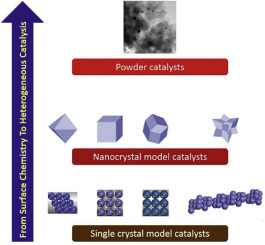Surface Science Reports ( IF 9.8 ) Pub Date : 2019-07-29 , DOI: 10.1016/j.surfrep.2019.100471 Shilong Chen , Feng Xiong , Weixin Huang

|
Fundamental understandings of surface chemistry and catalysis of solid catalysts are of great importance for the developments of efficient catalysts and corresponding catalytic processes, but have been remaining as a challenge due to the complex nature of heterogeneous catalysis. Model catalysts approach based on catalytic materials with uniform and well-defined surface structures is an effective strategy. Single crystals-based model catalysts have been successfully used for surface chemistry studies of solid catalysts, but encounter the so-called “materials gap” and “pressure gap” when applied for catalysis studies of solid catalysts. Recently catalytic nanocrystals with uniform and well-defined surface structures have emerged as a novel type of model catalysts whose surface chemistry and catalysis can be studied under the same operational reaction condition as working powder catalysts, and they are recognized as a novel type of model catalysts that can bridge the “materials gap” and “pressure gap” between single crystals-based model catalysts and powder catalysts. Herein we review recent progress of surface chemistry and catalysis of important oxide catalysts including CeO2, TiO2 and Cu2O acquired by model catalysts from single crystals to nanocrystals with an aim at summarizing the commonalities and discussing the differences among model catalysts with complexities at different levels. Firstly, the complex nature of surface chemistry and catalysis of solid catalysts is briefly introduced. In the following sections, the model catalysts approach is described and surface chemistry and catalysis of CeO2, TiO2 and Cu2O single crystal and nanocrystal model catalysts are reviewed. Finally, concluding remarks and future prospects are given on a comprehensive approach of model catalysts from single crystals to nanocrystals for the investigations of surface chemistry and catalysis of powder catalysts approaching the working conditions as closely as possible.
中文翻译:

从单晶到纳米晶体的氧化物模型催化剂的表面化学和催化
对于固体催化剂的表面化学和催化作用的基本理解对于开发高效催化剂和相应的催化过程非常重要,但由于非均相催化作用的复杂性,仍然是一个挑战。基于具有均匀且定义明确的表面结构的催化材料的模型催化剂方法是一种有效的策略。基于单晶的模型催化剂已经成功地用于固体催化剂的表面化学研究,但是当用于固体催化剂的催化研究时会遇到所谓的“材料间隙”和“压力间隙”。近年来,具有均匀且定义明确的表面结构的催化纳米晶体已经成为一种新型的模型催化剂,其表面化学和催化作用可以在与工作粉末催化剂相同的操作反应条件下进行研究,并且被公认为一种新型的模型催化剂。可以弥合基于单晶的模型催化剂和粉末催化剂之间的“材料间隙”和“压力间隙”。在本文中,我们回顾了表面化学和包括CeO在内的重要氧化物催化剂的催化作用的最新进展2,的TiO 2和Cu 2 ö获取由从单晶模型催化剂纳米晶体,目的在总结共同点和与在不同级别的复杂性讨论模型催化剂之间的差异。首先,简要介绍了表面化学和固体催化剂催化的复杂性质。在以下各节中,将描述模型催化剂的方法,以及CeO 2,TiO 2和Cu 2的表面化学和催化作用综述了单晶和纳米晶体模型催化剂。最后,对从单晶到纳米晶体的模型催化剂的综合研究方法作了总结和展望,以尽可能接近工作条件的方式研究粉末催化剂的表面化学和催化作用。


























 京公网安备 11010802027423号
京公网安备 11010802027423号